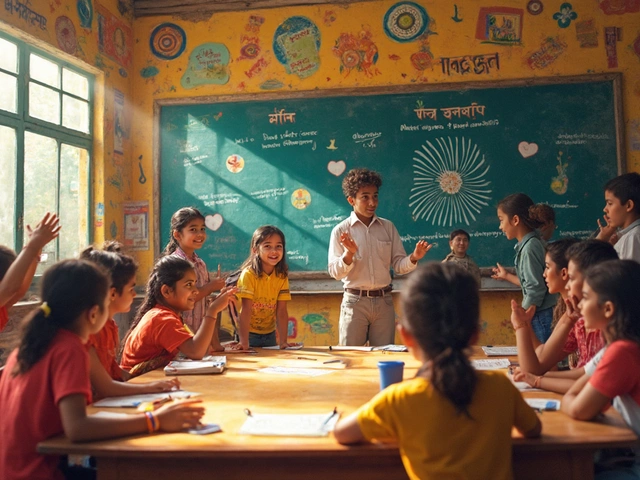The school bell rings and suddenly, your kid is raiding the fridge like they haven’t eaten in days. Sound familiar? You’re not alone. Kids get crazy hungry after school, and it’s not just because they skipped out on lunch (though, let’s be honest, sometimes they do).
During a school day, their brains and bodies are running full speed—listening in class, solving math problems, running at recess, maybe even squeezing in a club or sport before heading home. That’s a whole lot of calories burned, even if they were just sitting through a test or stretching their legs at drama club.
But there’s more going on than just energy use. Some schools have lunch as early as 10:30 am and by 3 pm, most kids are running on empty. The timing between meals actually matters. Plus, many after-school programs kick into gear right after the final bell, so there’s not much time to chill (or snack) before more activity starts.
- What’s Really Happening in Your Kid’s Day?
- The Role of School Lunch (Or Lack Thereof)
- After-School Clubs: Brainpower and Burnout
- Is It Real Hunger or Just Habit?
- Smart Snacking: What Actually Works
- Simple Strategies to Keep Hunger in Check
What’s Really Happening in Your Kid’s Day?
Kids’ schedules are busier and more packed than a lot of adults realize. From the moment they step into school, their brains and bodies kick into work mode without much of a slowdown. Take a look at a regular day: there’s math, reading, group projects, physical education, maybe art or music, and for a lot of kids, something extra like an early-morning club or tutoring.
Even younger students get a full plate of activities. Then pile on stuff that doesn't show up on their daily planners: stress from tests, drama between classmates, and just trying to remember what’s for homework. Their bodies burn food faster than you’d think just by staying focused, keeping up with friends, and coping with all that running around. No surprise, their energy tanks run empty by mid-afternoon.
On top of all that, after-school clubs add another layer of movement and mental work. Whether it’s coding club, sports, theater, or chess, these programs keep kids busy well past the final bell and definitely ramp up the hunger.
Here’s what a classic school day can look like for most elementary and middle school kids:
- 7:30 am – Arrive at school, morning brainwork starts
- 10:30-11:30 am – Early lunch in many districts
- 12:00-2:00 pm – Core academic classes, high focus
- 2:00-3:00 pm – Recess, arts, special subjects
- 3:00 pm+ – After-school clubs or sports begin
Check out how their day stacks up calorie-wise (average numbers per child age 7-14, so it’s just a guide):
| Activity | Estimated Calories Used (per hour) |
|---|---|
| Sitting in class (mental work) | 80-100 |
| Recess/PE (moderate activity) | 150-200 |
| After-school club (active/sport) | 140-250 |
| After-school club (quiet/creative) | 90-120 |
With all this going on, it’s no wonder the hungry kids phenomenon is real after a long day. Their bodies need to refuel, especially before more learning or movement takes place.
The Role of School Lunch (Or Lack Thereof)
Let’s be real, school lunch isn’t always the hearty, balanced meal kids need. Sometimes the lunch is too early, too rushed, or just not filling enough. In some schools, lunch can start as early as 10:30 am—which means by the afternoon, energy levels are dipping.
Truth is, many kids barely eat what’s on their tray. Maybe the food isn’t appealing, maybe they’re distracted by friends, or maybe they just want to play. The National School Lunch Program says about 29.6 million children get a school lunch each day, but studies show that only about 59% of students actually finish their lunch. Kids who bring food from home often stick to their favorite snacks, which can be carb-heavy and low on protein.
| Lunch Factor | Impact on Afterschool Hunger |
|---|---|
| Early lunch (before 11 am) | Longer gap before next meal, more hunger |
| Unappealing food | Kids eat less, less energy for later |
| Skipped lunch (talking, distracted) | No energy reserve after school |
| Quick meals (10-15 min to eat) | Not enough time to finish food |
The food itself is only part of the problem. Kids get rushed through lunch periods—some have less than 15 minutes to actually eat, and research from the Harvard T.H. Chan School of Public Health found that when kids have less than 20 minutes, they eat significantly less fruits and veggies.
This means that by the time the hungry kids get out of school and into their after-school club, they’re often running on fumes. So it’s no surprise they come home with serious cravings—it’s their bodies’ way of playing catch-up.
After-School Clubs: Brainpower and Burnout
If you think after-school clubs are just about extra playtime, think again. These programs can soak up just as much energy as the school day itself. Between chess club, robotics, choir, and sports, kids juggle a mix of physical and mental challenges. The demand for concentration and teamwork, especially late in the day, leaves many students wiped out. That hunger you see isn’t just from running around. It’s brainwork too.
A cool fact: Just an hour of intense thinking (like learning lines for theater or focusing on programming) can use up as much energy as a brisk walk. According to a 2022 study by the University of Nebraska, kids in after-school programs burn about 10-20% more energy than on days they just go home after class.
“After-school time is prime time for both learning and movement. The body and brain both burn through more fuel, which explains why kids often come home desperate for food,” says Dr. Emily Harris, pediatric nutritionist at Boston Children’s Hospital.
Take a look at this breakdown of average activity and energy use in some common after-school clubs:
| Club Type | Avg. Minutes Active | Extra Calories Burned |
|---|---|---|
| Sports (Soccer, Basketball) | 60 | 200-300 |
| Drama | 45 | 80-120 |
| STEM/Robotics | 60 | 50-100 |
| Music/Choir | 30 | 40-60 |
No matter which club your kid chooses, there’s some level of “brain drain” happening. Add on the skipped or early lunch from earlier in the day, and you end up with a perfect storm for after-school hunger.
If your student’s club runs long, or goes past the usual dinner hour, make sure they’ve got a filling snack in their bag. Think something with both protein and carbs for steady energy—like a cheese stick and some crackers, or a handful of trail mix. Quick, easy, and way better than running on empty.

Is It Real Hunger or Just Habit?
You know that scene: the backpack hits the floor, shoes kick off, and before you can say "hello," your kid is digging for snacks. It's worth stopping to ask—are they truly hungry, or is it just a routine?
Let's break it down. Real hunger means your kid's body is running low on fuel. Habit hunger, though, is a different story—it's when grabbing a snack after school is just part of their daily pattern, even if they're not physically hungry. It's a thing researchers actually track. Kids who snack out of habit tend to eat more overall, which can mess with their hunger cues over time.
One way to tell the difference: check if they're willing to eat something healthy (like carrot sticks or an apple). If the answer is nope, it's probably not true hunger. Real hunger isn't picky. Also, check in on the timing—they probably last ate lunch four or five hours ago, so there's a good chance their body genuinely needs something.
| Sign | Real Hunger | Habit |
|---|---|---|
| Willing to eat healthy options | Yes | No |
| Time since last meal | 4+ hours | Less than 2 hours |
| Physical signs (tummy rumbling, low energy) | Common | Rare |
| Craves specific snacks (chips, sweets) | No | Yes |
Fun fact: a recent youth nutrition survey found over 60% of students reach for snacks out of habit while watching TV or as soon as they walk in the door. It’s not really about being hungry kids; it’s just part of how their after-school flow works.
If you want to help your child figure it out, try a quick "hunger check". Ask them to rate their hunger on a scale from 1 to 5. If they're at a 4 or 5, it's probably legit. This tiny pause can save you from lots of mindless munching—and it’s a skill they’ll use for life.
Smart Snacking: What Actually Works
Kids don’t need fancy protein shakes or expensive health bars to refuel after school. The real trick is getting the right mix of foods that keep them full and help them focus. You want to avoid stuff that spikes energy then lets it crash (hello, sugary cookies and chips). Instead, think about snacks that have both protein and fiber, because they’re the combo that actually sticks with them until dinner.
- Yogurt with berries and a handful of granola gives protein, carbs, and fiber in one go.
- Apple slices with peanut butter are classic for a reason—it’s the sweet, salty, crunch combo that lasts.
- Cheese and whole grain crackers are a lifesaver on busy days, easy to pack, and keep hunger down.
- Trail mix (watch the portion size if there’s chocolate or candies mixed in) can be a fun energy boost.
- Baby carrots or cucumber sticks with hummus are awesome for kids who prefer something savory.
The important thing is the balance. Kids burn through their fuel quickly during and after school, especially if they’re in after-school clubs. A plain granola bar or a piece of fruit alone might not cut it, but pair them together or add some nuts, and you’re set.
Another tip: timing matters. Have snacks ready to go as soon as they come home or keep a box in the car if you’re driving straight from school to soccer practice. When snacks are easy to grab, it stops the constant “I’m hungry!” whine and helps everyone stick to a regular mealtime later on.
Simple Strategies to Keep Hunger in Check
Kids blast through calories during the school day and after-school clubs, so your best move is to plan ahead. Keeping hunger in check isn’t about fancy snacks or brand-name bars—it’s about quick, real food and timing it right.
First things first, talk to your kid about what they eat and when they actually get hungry. You might be surprised at what you learn. Some skip breakfast; others throw away parts of their lunch just because they’re in a hurry to get outside.
- Pack snacks with protein and fiber. Think cheese sticks, apple slices with peanut butter, trail mix, or Greek yogurt. These choices keep kids fuller longer than a handful of chips or cookies.
- Make snacks easy to grab. If your kid’s heading out to after-school clubs, something portable—like an energy bar or a banana—can go a long way. Set up a "snack bin" at home so they know where to look.
- Keep an eye on drinks. A lot of kids confuse thirst for hunger. Send them to school with a full reusable water bottle and remind them to actually drink it.
- Try a snack schedule. If your child eats lunch early at school, it makes sense they'll be hungry by the time they're home. Have a set snack time right after school, before dinner, so they don’t spoil their appetite for the main meal.
If you want a quick peek at how some common after-school snacks stack up for nutrition, check out this table:
| Snack | Calories | Protein (g) | Fiber (g) |
|---|---|---|---|
| Cheese stick + whole-wheat crackers | 180 | 7 | 2 |
| Apple + peanut butter | 160 | 4 | 3 |
| Yogurt tube | 60 | 2 | 0 |
| Packaged granola bar (average) | 110 | 2 | 1 |
If you notice your child is always starving right after their club or activity, that’s a cue to pack a little extra for them to eat on the way or during a break. Encouraging them to listen to their own hunger cues (and thirst!) helps teach good habits for life.







